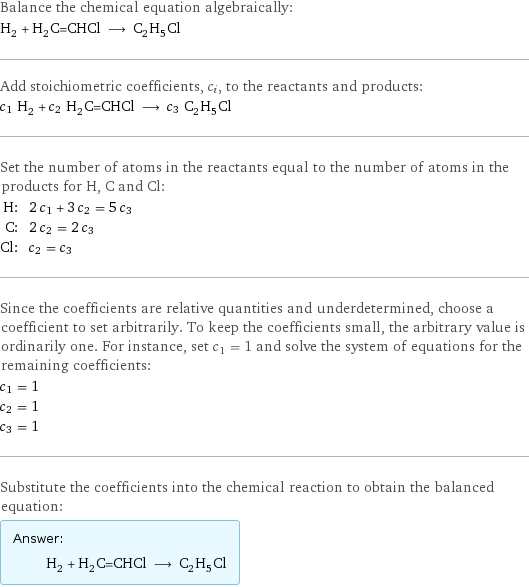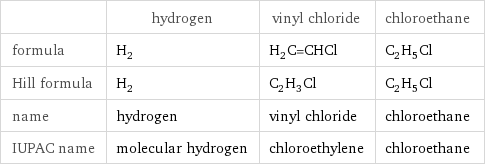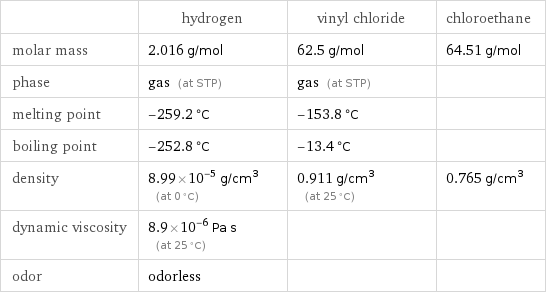Input interpretation

H_2 hydrogen + H_2C=CHCl vinyl chloride ⟶ C_2H_5Cl chloroethane
Balanced equation

Balance the chemical equation algebraically: H_2 + H_2C=CHCl ⟶ C_2H_5Cl Add stoichiometric coefficients, c_i, to the reactants and products: c_1 H_2 + c_2 H_2C=CHCl ⟶ c_3 C_2H_5Cl Set the number of atoms in the reactants equal to the number of atoms in the products for H, C and Cl: H: | 2 c_1 + 3 c_2 = 5 c_3 C: | 2 c_2 = 2 c_3 Cl: | c_2 = c_3 Since the coefficients are relative quantities and underdetermined, choose a coefficient to set arbitrarily. To keep the coefficients small, the arbitrary value is ordinarily one. For instance, set c_1 = 1 and solve the system of equations for the remaining coefficients: c_1 = 1 c_2 = 1 c_3 = 1 Substitute the coefficients into the chemical reaction to obtain the balanced equation: Answer: | | H_2 + H_2C=CHCl ⟶ C_2H_5Cl
Structures

+ ⟶
Names

hydrogen + vinyl chloride ⟶ chloroethane
Equilibrium constant
![Construct the equilibrium constant, K, expression for: H_2 + H_2C=CHCl ⟶ C_2H_5Cl Plan: • Balance the chemical equation. • Determine the stoichiometric numbers. • Assemble the activity expression for each chemical species. • Use the activity expressions to build the equilibrium constant expression. Write the balanced chemical equation: H_2 + H_2C=CHCl ⟶ C_2H_5Cl Assign stoichiometric numbers, ν_i, using the stoichiometric coefficients, c_i, from the balanced chemical equation in the following manner: ν_i = -c_i for reactants and ν_i = c_i for products: chemical species | c_i | ν_i H_2 | 1 | -1 H_2C=CHCl | 1 | -1 C_2H_5Cl | 1 | 1 Assemble the activity expressions accounting for the state of matter and ν_i: chemical species | c_i | ν_i | activity expression H_2 | 1 | -1 | ([H2])^(-1) H_2C=CHCl | 1 | -1 | ([H2C=CHCl])^(-1) C_2H_5Cl | 1 | 1 | [C2H5Cl] The equilibrium constant symbol in the concentration basis is: K_c Mulitply the activity expressions to arrive at the K_c expression: Answer: | | K_c = ([H2])^(-1) ([H2C=CHCl])^(-1) [C2H5Cl] = ([C2H5Cl])/([H2] [H2C=CHCl])](../image_source/cc5bb48e6dae34f8c02b5e574cd38f60.png)
Construct the equilibrium constant, K, expression for: H_2 + H_2C=CHCl ⟶ C_2H_5Cl Plan: • Balance the chemical equation. • Determine the stoichiometric numbers. • Assemble the activity expression for each chemical species. • Use the activity expressions to build the equilibrium constant expression. Write the balanced chemical equation: H_2 + H_2C=CHCl ⟶ C_2H_5Cl Assign stoichiometric numbers, ν_i, using the stoichiometric coefficients, c_i, from the balanced chemical equation in the following manner: ν_i = -c_i for reactants and ν_i = c_i for products: chemical species | c_i | ν_i H_2 | 1 | -1 H_2C=CHCl | 1 | -1 C_2H_5Cl | 1 | 1 Assemble the activity expressions accounting for the state of matter and ν_i: chemical species | c_i | ν_i | activity expression H_2 | 1 | -1 | ([H2])^(-1) H_2C=CHCl | 1 | -1 | ([H2C=CHCl])^(-1) C_2H_5Cl | 1 | 1 | [C2H5Cl] The equilibrium constant symbol in the concentration basis is: K_c Mulitply the activity expressions to arrive at the K_c expression: Answer: | | K_c = ([H2])^(-1) ([H2C=CHCl])^(-1) [C2H5Cl] = ([C2H5Cl])/([H2] [H2C=CHCl])
Rate of reaction
![Construct the rate of reaction expression for: H_2 + H_2C=CHCl ⟶ C_2H_5Cl Plan: • Balance the chemical equation. • Determine the stoichiometric numbers. • Assemble the rate term for each chemical species. • Write the rate of reaction expression. Write the balanced chemical equation: H_2 + H_2C=CHCl ⟶ C_2H_5Cl Assign stoichiometric numbers, ν_i, using the stoichiometric coefficients, c_i, from the balanced chemical equation in the following manner: ν_i = -c_i for reactants and ν_i = c_i for products: chemical species | c_i | ν_i H_2 | 1 | -1 H_2C=CHCl | 1 | -1 C_2H_5Cl | 1 | 1 The rate term for each chemical species, B_i, is 1/ν_i(Δ[B_i])/(Δt) where [B_i] is the amount concentration and t is time: chemical species | c_i | ν_i | rate term H_2 | 1 | -1 | -(Δ[H2])/(Δt) H_2C=CHCl | 1 | -1 | -(Δ[H2C=CHCl])/(Δt) C_2H_5Cl | 1 | 1 | (Δ[C2H5Cl])/(Δt) (for infinitesimal rate of change, replace Δ with d) Set the rate terms equal to each other to arrive at the rate expression: Answer: | | rate = -(Δ[H2])/(Δt) = -(Δ[H2C=CHCl])/(Δt) = (Δ[C2H5Cl])/(Δt) (assuming constant volume and no accumulation of intermediates or side products)](../image_source/face641d2f88903705afc3e6c3a4e473.png)
Construct the rate of reaction expression for: H_2 + H_2C=CHCl ⟶ C_2H_5Cl Plan: • Balance the chemical equation. • Determine the stoichiometric numbers. • Assemble the rate term for each chemical species. • Write the rate of reaction expression. Write the balanced chemical equation: H_2 + H_2C=CHCl ⟶ C_2H_5Cl Assign stoichiometric numbers, ν_i, using the stoichiometric coefficients, c_i, from the balanced chemical equation in the following manner: ν_i = -c_i for reactants and ν_i = c_i for products: chemical species | c_i | ν_i H_2 | 1 | -1 H_2C=CHCl | 1 | -1 C_2H_5Cl | 1 | 1 The rate term for each chemical species, B_i, is 1/ν_i(Δ[B_i])/(Δt) where [B_i] is the amount concentration and t is time: chemical species | c_i | ν_i | rate term H_2 | 1 | -1 | -(Δ[H2])/(Δt) H_2C=CHCl | 1 | -1 | -(Δ[H2C=CHCl])/(Δt) C_2H_5Cl | 1 | 1 | (Δ[C2H5Cl])/(Δt) (for infinitesimal rate of change, replace Δ with d) Set the rate terms equal to each other to arrive at the rate expression: Answer: | | rate = -(Δ[H2])/(Δt) = -(Δ[H2C=CHCl])/(Δt) = (Δ[C2H5Cl])/(Δt) (assuming constant volume and no accumulation of intermediates or side products)
Chemical names and formulas

| hydrogen | vinyl chloride | chloroethane formula | H_2 | H_2C=CHCl | C_2H_5Cl Hill formula | H_2 | C_2H_3Cl | C_2H_5Cl name | hydrogen | vinyl chloride | chloroethane IUPAC name | molecular hydrogen | chloroethylene | chloroethane
Substance properties

| hydrogen | vinyl chloride | chloroethane molar mass | 2.016 g/mol | 62.5 g/mol | 64.51 g/mol phase | gas (at STP) | gas (at STP) | melting point | -259.2 °C | -153.8 °C | boiling point | -252.8 °C | -13.4 °C | density | 8.99×10^-5 g/cm^3 (at 0 °C) | 0.911 g/cm^3 (at 25 °C) | 0.765 g/cm^3 dynamic viscosity | 8.9×10^-6 Pa s (at 25 °C) | | odor | odorless | |
Units
